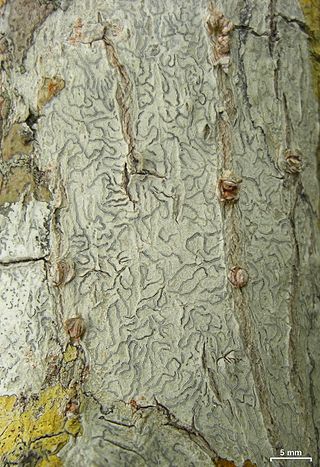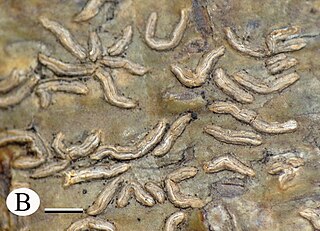Thalloloma is a genus of lichens in the family Graphidaceae. It contains 20 species.

Sarcographa is a genus of lichen-forming fungi in the family Graphidaceae. It is estimated to contain 37 species. The genus was circumscribed by French botanist Antoine Laurent Apollinaire Fée in 1825.

Platythecium is a genus of lichen-forming fungi in the family Graphidaceae. It contains an estimated 27 species.

Platygramme is a genus of lichen-forming fungi in the family Graphidaceae consisting of about 30 species. The genus was circumscribed by Antoine Laurent Apollinaire Fée in 1874.

Phaeographis is a genus of lichen-forming fungi in the family Graphidaceae. It has an estimated 180 species.

Phaeographina is a genus of lichen-forming fungi in the family Graphidaceae. The genus was circumscribed by Swiss lichenologist Johannes Müller Argoviensis in 1882.
Hemithecium is a genus of lichen-forming fungi in the family Graphidaceae. The genus was circumscribed by Vittore Benedetto Antonio Trevisan de Saint-Léon in 1853.

Graphis is a genus of lichen-forming fungi in the family Graphidaceae.

Glyphis is a genus of lichen-forming fungi in the family Graphidaceae. The genus has a widespread distribution, especially in tropical regions.

Fissurina is a genus of lichenized fungi in the family Graphidaceae. It has about 160 species, most of which are found in tropical regions.

Diorygma is a genus of lichen-forming fungi in the family Graphidaceae. The genus was circumscribed by Franz Gerhard Eschweiler in 1824. Species of the genus are widely distributed in tropical and subtropical regions of the world.
Carbacanthographis is a genus of corticolous (bark-dwelling) lichens in the family Graphidaceae. The genus was circumscribed by German lichenologists Bettina Staiger and Klaus Kalb in 2002. An updated worldwide key to the genus was published in 2022 that added 17 new species.

Acanthothecis is a genus of lichen-forming fungi in the family Graphidaceae. The genus was circumscribed by Frederick Edward Clements in 1909.

Pyxine is a genus of foliose lichens in the family Caliciaceae. The genus has a widespread distribution in tropical regions.

Cryptothecia is a genus of white to greenish crustose lichens that grow on bark, wood, or leaves. in tropical or subtropical areas worldwide. It has a conspicuous prothallus that develops around its periphery which can be bright red in some species, hence the common name wreath lichen. The main vegetative body (thallus) lacks a cortex (ecorticate and is often immersed in the substrate or byssoid. The medulla is white, well defined, and often peppered with calcium oxalate crystals. Ascomata are not well defined, being cushions of soft white mycelium immersed in the medullary tissue, hence the name from the Greek krypto = "to conceal" and theke = "a container or sheath". There are about 45 described species in the genus according to one source, and 75 species according to another. The genus is in the family Arthoniaceae. It contains Trentepohlia, a green alga, as its photobiont partner.
Halegrapha is a genus of lichen-forming fungi in the family Graphidaceae. It has nine species. The genus was circumscribed in 2011 by Eimy Rivas Plata and Robert Lücking, with Halegrapha chimaera assigned as the type species. The generic name honors American lichenologist Mason Hale.

Graphina is a genus of script lichens in the family Graphidaceae. It has about 25 species. The genus was circumscribed in 1880 by Swiss lichenologist Johannes Müller Argoviensis. Müller Argoviensis did not indicate a type species for the genus in his original publication; David Hawksworth proposed to designate Graphina anguina as a lectotype in 1981.

Platythecium hypoleptum is a species of corticolous (bark-dwelling), crustose lichen in the family Graphidaceae.
Graphidales is an order of lichen-forming fungi in the class Lecanoromycetes. It contains 6 families, about 81 genera and about 2,228 species. Family Graphidaceae are the largest crustose family within Graphidales order comprising more than 2000 species, which are widely distributed in tropical and subtropical regions of the world.
Pallidogramme is a genus of lichen-forming fungi in the family Graphidaceae. It has 8 species of corticolous (bark-dwelling), crustose lichens.














